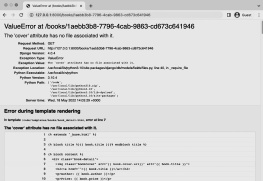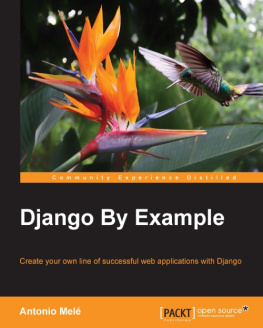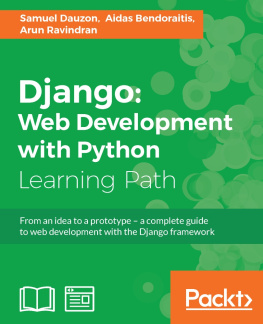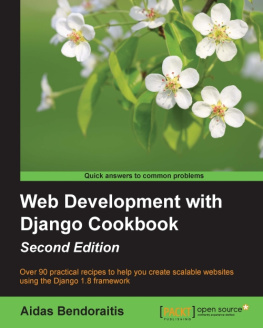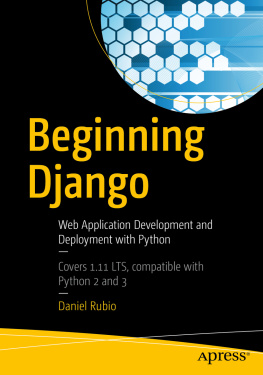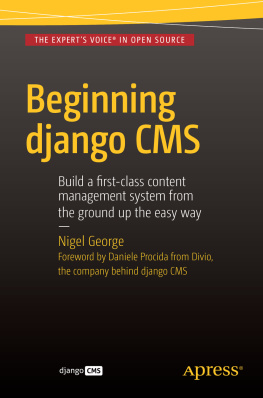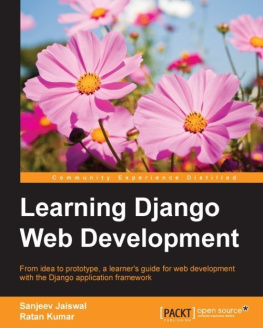William S. Vincent - Django for Beginners: Build websites with Python and Django (Welcome to Django Book 1)
Here you can read online William S. Vincent - Django for Beginners: Build websites with Python and Django (Welcome to Django Book 1) full text of the book (entire story) in english for free. Download pdf and epub, get meaning, cover and reviews about this ebook. year: 2018, publisher: WelcomeToCode, genre: Computer. Description of the work, (preface) as well as reviews are available. Best literature library LitArk.com created for fans of good reading and offers a wide selection of genres:
Romance novel
Science fiction
Adventure
Detective
Science
History
Home and family
Prose
Art
Politics
Computer
Non-fiction
Religion
Business
Children
Humor
Choose a favorite category and find really read worthwhile books. Enjoy immersion in the world of imagination, feel the emotions of the characters or learn something new for yourself, make an fascinating discovery.

- Book:Django for Beginners: Build websites with Python and Django (Welcome to Django Book 1)
- Author:
- Publisher:WelcomeToCode
- Genre:
- Year:2018
- Rating:4 / 5
- Favourites:Add to favourites
- Your mark:
Django for Beginners: Build websites with Python and Django (Welcome to Django Book 1): summary, description and annotation
We offer to read an annotation, description, summary or preface (depends on what the author of the book "Django for Beginners: Build websites with Python and Django (Welcome to Django Book 1)" wrote himself). If you haven't found the necessary information about the book — write in the comments, we will try to find it.
Completely updated for Django 4.0.
Django for Beginners is a project-based introduction to Django, the popular Python-based web framework. Suitable for total beginners who have never built a website before as well as professional programmers looking for a fast-paced guide to modern web development and Django fundamentals.
In the book youll learn how to:
- Build 5 websites from scratch, including a Blog and Newspaper website
- Deploy online using security best practices
- Customize the look and feel of your sites
- Write tests and run them for all your code
- Integrate user authentication, email, and custom user models
- Add permissions and authorizations to make your app more secure
- Identify common mistakes and errors so you can build your own websites
If youre curious about Python-based web development, Django for Beginners is a best-practices guide to writing and deploying your own websites quickly.
When readers interested in web development ask me what to read next after Python Crash Course, I refer them to Wills books: Django for Beginners, Django for APIs, and Django for Professionals. I highly recommend you check out his work.ERIC MATTHES, author of Python Crash Course
If youre looking for a guide into the world of Django, then the three-step of Django for Beginners, Django for APIs, and Django for Professionals is ideal: get up and running, get into APIs, which are a cornerstone of modern app development, and then add the bits you need to your fledging app into production, from databases and static files, to user accounts and security. Its a long road. Wills books are an awesome companion.CARLTON GIBSON, Django Fellow and Django REST Framework core contributor
Wills books are a fantastic resource for web development with Django and Python. I highly recommended themJEFF TRIPLETT, Python Software Foundation Director, DEFNA President, and REVSYS Partner
William S. Vincent: author's other books
Who wrote Django for Beginners: Build websites with Python and Django (Welcome to Django Book 1)? Find out the surname, the name of the author of the book and a list of all author's works by series.

